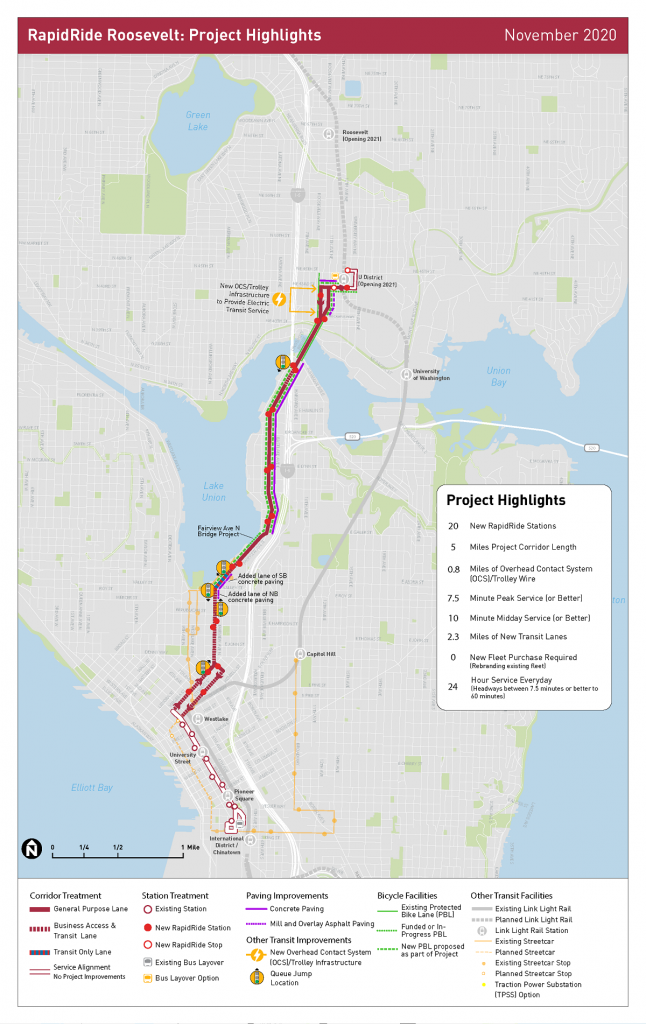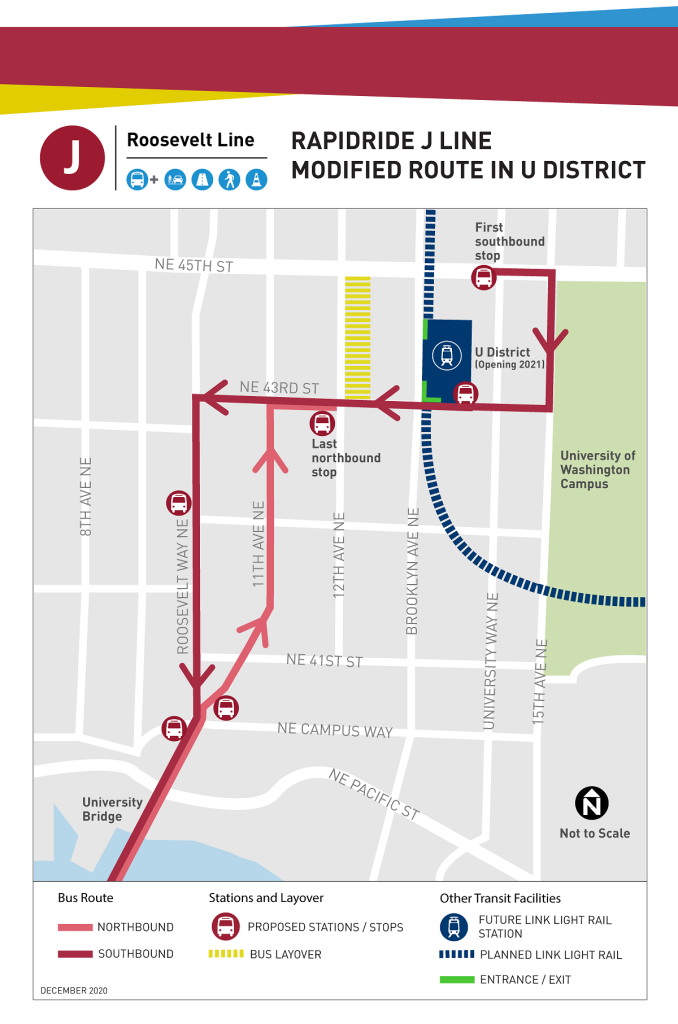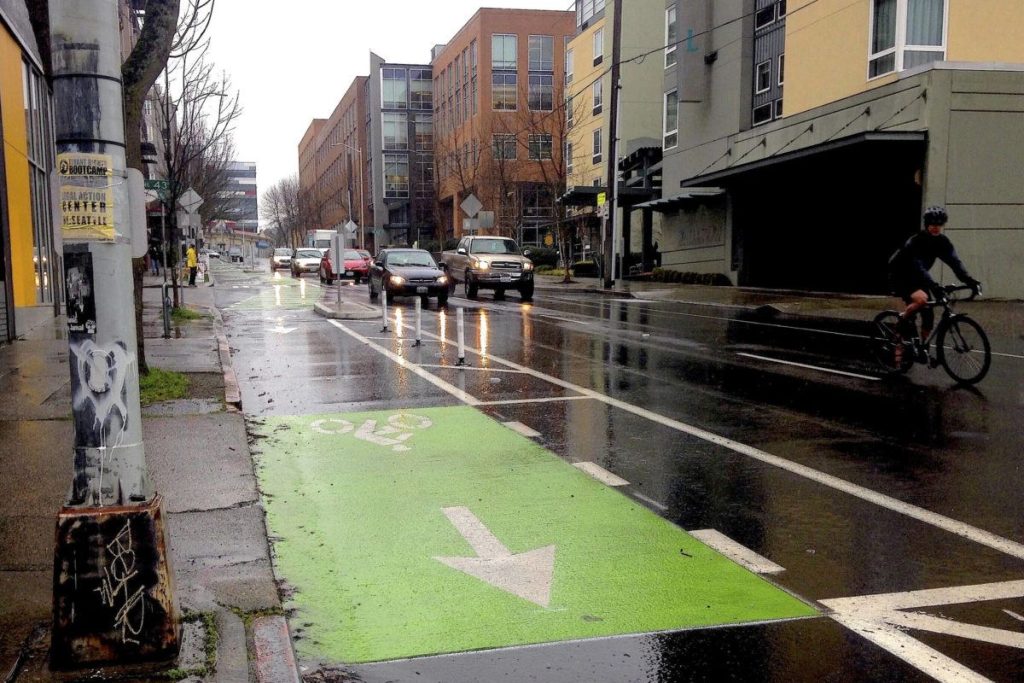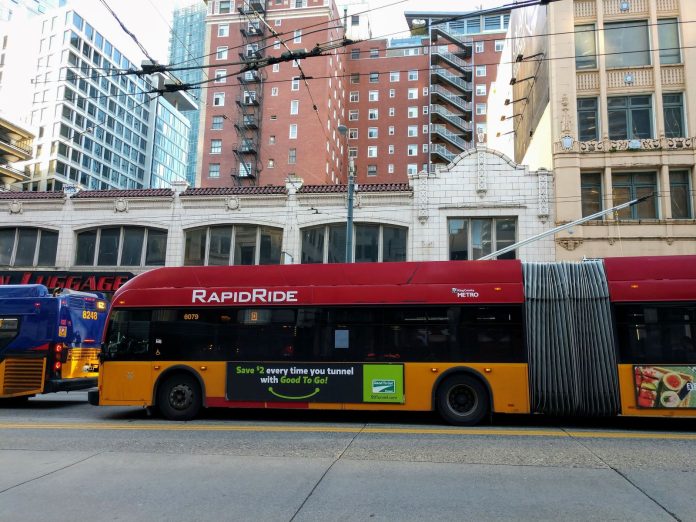An online open house Wednesday was first big chance for the public to weigh in on RapidRide J’s new plan which has been shortened to terminate at U District Station due to funding constraints. Those changes have pushed backed the expected opening of the line from 2024 to 2025 or 2026. The presentation focused on the section of the route north of University Bridge, as no alignment changes have been planned for RapidRide J south of the bridge, and representatives from the Seattle Department of Transportation (SDOT) and King County Metro answered questions on the alterations.
As discussed in The Urbanist’s last piece on the bus service, RapidRide J was initially envisioned to reach as far as Northgate Station. That alignment was revised to end at Roosevelt Station, and now it’s planned to just reach the University District Station. The latest adjustments are a result of Covid-19 induced budget shortfalls. The alignment will serve Downtown, Belltown, South Lake Union, Eastlake, and the University District, and supplant Route 70 whose pre-pandemic peak service ran late 30% of the time and was overcrowded 60% of the time. The bus rapid transit (BRT) improvement to the corridor will improve speed, reliability, and connections with bus only lanes, upgraded traffic signals, and additional trips.

SDOT expressed confidence that the alignment will be consistent with community expectations, still be able to help them secure grant funding, and be compatible to future northward expansion. Riders will be able to reach Northgate and Roosevelt with bus or light rail transfers, and the agencies argued there will still be plenty of bus service in the area, reducing the inconvenience that a transfer might incur. The agency will be submitting a supplement environment assessment to reflect the changes to the route’s alignment.
A closer look at the changes
Upon close inspection, the modifications create awkward stop placements. It’s especially concerning when access to light rail is less smooth, it has been pointed out that the northbound routing abruptly terminates a block away or two street crossings from the U District light rail station. SDOT chalked up that inconvenience to the combination of the need for access to bus layover space–necessary to give bus drivers breaks–and budget and reliability restraints that only allows for a singular loop around the light rail station. A double loop consideration that would allow riders to be dropped off closer to the station was eliminated after a cost benefit analysis was done by SDOT.

The alignment also departs from Route 70, which could disrupt the established travel patterns of current riders. When addressing the change, SDOT first touched on reliability. The agency highlighted 15th Ave NE’s tendency for congestion, and the additional turns on the old route. Realignment to Roosevelt and 11th ensure higher reliability expected of a BRT service. Future compatibility is also cited as a reason to align the RapidRide lines on Roosevelt and 11th rather than Route 70’s routing. The change preserves an easier expansion northward.
In the presentation, SDOT made sure to emphasize the forward compatibility of the project on multiple occasions. It seems like there’s a desire within the agency to make the line a true Roosevelt RapidRide if funding is made available. Perhaps, it could even make its way up to the Northgate Transit Center and also supplant Route 67. Maybe we’ll see SDOT be able to return Roosevelt to the alignment, as construction is only expected to start in 2023, we have plenty of time for the economy and funding to recover as immunization begins to spread in 2021.
Future compatibility is also considered for planned bus stop infrastructure. Only the three stops closest to the bridge will be getting standard RapidRide amenities. The last northbound stop will just be getting a sign because it’s just an alighting stop, riders will only be able to get off the bus there. The first southbound stop doesn’t have space for all of the standard RapidRide amenities, and the southbound stop in front of the Link station will be getting extra amenities as Sound Transit will also be contributing to the planned and potentially heavily trafficked stop. One could assume that if they want to extend farther north, alignment would continue on Roosevelt and 11th and leave little infrastructure behind.
What else and what’s next
The project is not exclusive to BRT improvements, bicyclists and pedestrians will also be seeing benefit in the corridor. New protected bike lanes will be coming to the U District, and questions on what side of the road they’ll be on for 11th Ave NE also came up. SDOT did comment on the upsides and downsides of each option saying that it was planned for the right side as of now–left side bike lanes on 11th wouldn’t have buses crossing into them, but require a transition from the existing right side bike lanes coming from the bridge. New ADA compliant curbs will also be installed along the corridor.

Fare enforcement did come up as well, SDOT couldn’t comment on it because the fare enforcement policy is in the process of being reviewed and potentially changed. The project is planned to start construction in 2023 with a completion date sometime in 2025 or 2026, so whatever policy then would apply to RapidRide J.
The future doesn’t look too bad for Seattle’s transit, it certainly is an improvement from rumors of RapidRide J’s demise. SDOT will be returning for public input sometime in 2021 for a 30-day comment period when the supplement Environmental Assessment is submitted. SDOT will also be collaborating with the community and business to discuss the impact of the abbreviated route. Ideally, the agency will receive regulatory approval and the new line will be running in a half decade. In the meantime, if you’d like to follow the BRT line’s development subscribe to project updates at the project’s website.
Shaun Kuo is a junior editor at The Urbanist and a recent graduate from the UW Tacoma Master of Arts in Community Planning. He is a urban planner at the Puget Sound Regional Council and a Seattle native that has lived in Wallingford, Northgate, and Lake Forest Park. He enjoys exploring the city by bus and foot.


